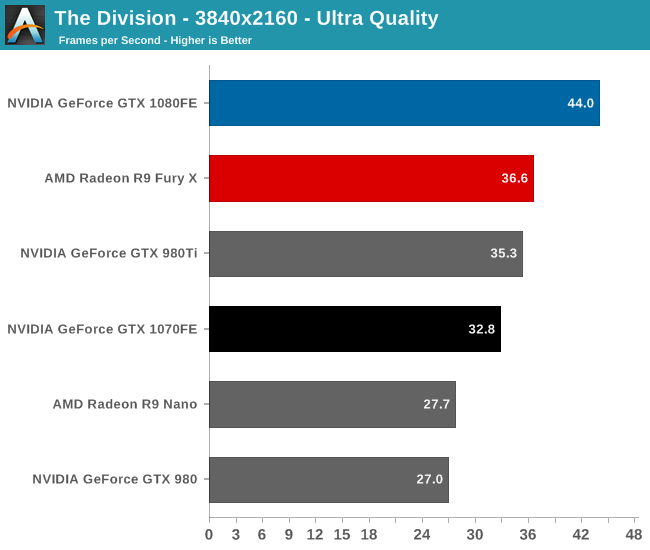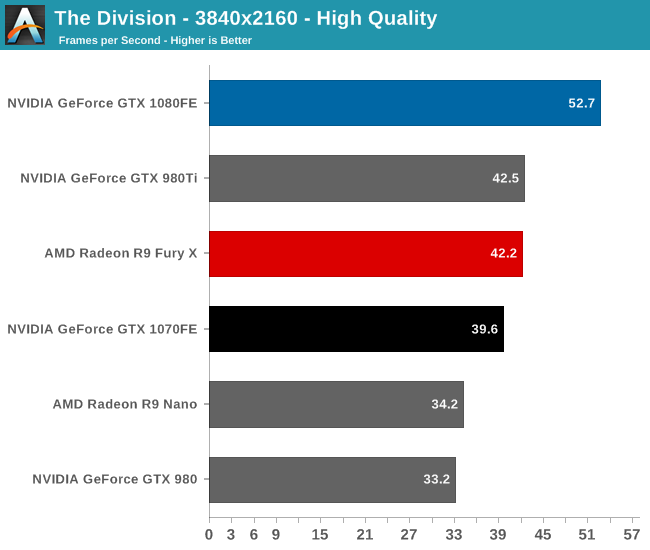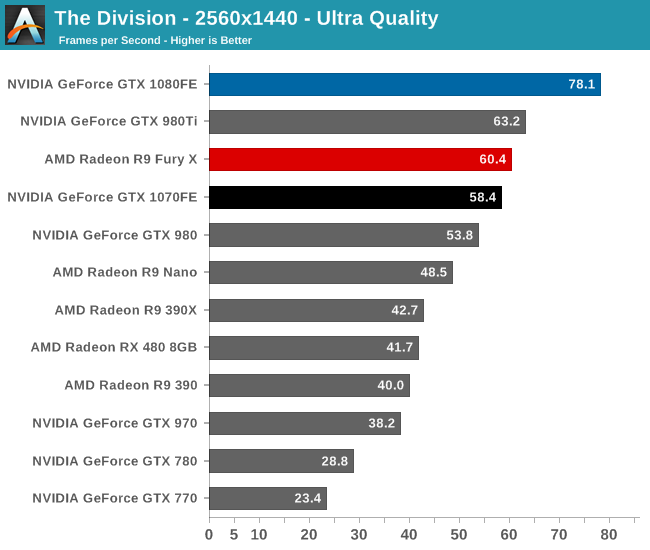The NVIDIA GeForce GTX 1080 & GTX 1070 Founders Editions Review: Kicking Off the FinFET Generation
by Ryan Smith on July 20, 2016 8:45 AM ESTThe Division
The final first person shooter in our benchmark suite, The Division is a multiplayer-only game powered by Ubisoft’s Snowdrop engine. The game’s design focuses on detailed urban environments and utilizes dynamic global illumination for parts of its lighting. For our testing we use the game’s built-in benchmark, which cycles through a number of scenes/areas of the game.



As a bit of an unknown when it comes to engines, we went ahead and benchmarked this game at 4K with both Ultra and High settings, to see how performance was impacted by reducing the image quality. The result is that even at High quality, the GTX 1080 isn’t going to be able to hit 60fps. When it comes to The Division and 4K, your options are to either put up with a framerate in the mid-40s or make greater image quality sacrifices. That said, the GTX 1080 does get the distinction of being the only card to even crack 40fps at 4K; the GTX 1070 isn’t doing much better than 30fps.
More than anything else, this game is unexpectedly sensitive to the differences between the GTX 1080 and GTX 1070. Normally the GTX 1080 would lead by 25% or so, but in The Division that’s a 33% to 40% lead. It’s more than you’d expect given the differences between the two cards’ configurations, and while I suspect it’s a combination of memory bandwidth differences and ALU throughput differences, I’m also not 100% convinced it’s not a bug of some kind. So we’ll have to see if this changes at all.
In any case, the more significant gap between the Pascal cards means that while GTX 1080 is comfortably leading, this is one of the only cases where GTX 1070 isn’t at least at parity with GTX 980 Ti. The gap closes with the resolution, but at all points GTX 1070 comes up short. It’s not a total wash for the GTX 1070 since it’s both significantly cheaper and significantly more energy efficient than GTX 980 Ti, but it’s very rare for the card not to be hanging relatively close to GTX 1080.
Looking at the generational differences, GTX 1080 enjoys a solid lead over GTX 980. With the exception of 1440p, it improves on its direct predecessor by 60% or more. Meanwhile GTX 1070, despite its greater handicap, is a consistent 50%+ faster than GTX 970.










200 Comments
View All Comments
Ryan Smith - Wednesday, July 20, 2016 - link
Thanks.Eden-K121D - Wednesday, July 20, 2016 - link
Finally the GTX 1080 reviewguidryp - Wednesday, July 20, 2016 - link
This echoes what I have been saying about this generation. It is really all about clock speed increases. IPC is essentially the same.This is where AMD lost out. Possibly in part the issue was going with GloFo instead of TSMC like NVidia.
Maybe AMD will move Vega to TSMC...
nathanddrews - Wednesday, July 20, 2016 - link
Curious... how did AMD lose out? Have you seen Vega benchmarks?TheinsanegamerN - Wednesday, July 20, 2016 - link
its all about clock speed for Nvidia, but not for AMD. AMD focused more on ICP, according to them.tarqsharq - Wednesday, July 20, 2016 - link
It feels a lot like the P4 vs Athlon XP days almost.stereopticon - Wednesday, July 20, 2016 - link
My favorite era of being a nerd!!! Poppin' opterons into s939 and pumpin the OC the athlon FX levels for a fraction of the price all while stompin' on pentium. It was a good (although expensive) time to a be a nerd... Besides paying 100 dollars for 1gb of DDR500. 6800gs budget friendly cards, and ATi x1800/1900 super beasts.. how i miss the dayseddman - Thursday, July 21, 2016 - link
Not really. Pascal has pretty much the same IPC as Maxwell and its performance increases accordingly with the clockspeed.Pentium 4, on the other hand, had a terrible IPC compared to Athlon and even Pentium 3 and even jacking its clockspeed to the sky didn't help it.
guidryp - Wednesday, July 20, 2016 - link
No one really improved IPC of their units.AMD was instead forced increase the unit count and chip size for 480 is bigger than the 1060 chip, and is using a larger bus. Both increase the chip cost.
AMD loses because they are selling a more expensive chip for less money. That squeezes their unit profit on both ends.
retrospooty - Wednesday, July 20, 2016 - link
"This echoes what I have been saying about this generation. It is really all about clock speed increases. IPC is essentially the same."- This is a good thing. Stuck on 28nm for 4 years, moving to 16nm is exactly what Nvidias architecture needed.